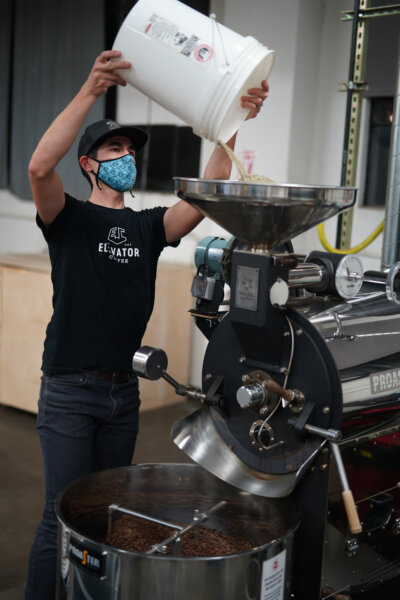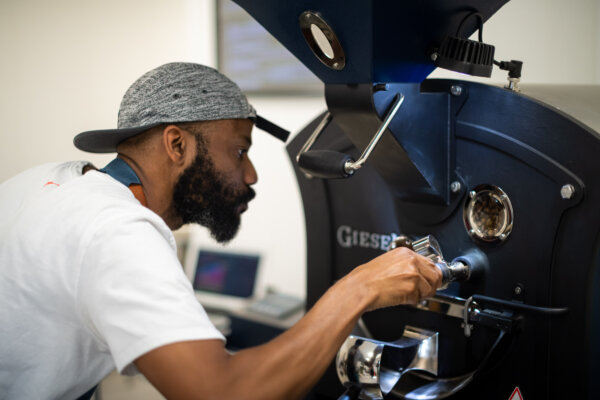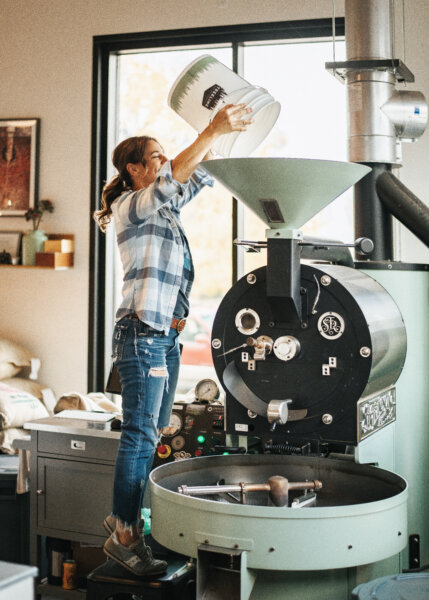Green coffee purchasing and menu planning have always been challenging, but the last few years have been a whole different game: tumultuous and volatile, requiring an unprecedented balancing act of flexibility and preparation. At this point, those who work with green coffee have had to develop a powerful arsenal of techniques for constructing beautifully diversified and balanced long- and short-term menus. To curate some top tips, we asked the experts: a selection of fantastic roaster partners who excel at menu planning strategy. Read on for a deep dive into seasonality, menu pacing, diversification, forward booking, and more.
Seasonality, Pacing & Freshness: Using Past Trends to Plan the Future

Photo courtesy of Variety Coffee
Menu planning is an act of juggling: coffees ripen, harvest, and arrive in staggered schedules through the year, and each has a unique profile and life cycle. How does one best harness these natural patterns to craft a menu that balances not just arrival dates but also factors like consistency against variety, larger lots against smaller lots, longevity against immediacy, and varied price points? The roasters we talked to factor domestic business cycles against origin harvest periods, and use historical patterns to predict near-term future needs.
Patrick Grzelewski of Variety Coffee in New York, NY, approaches the year holistically and allows the dynamism of coffee itself to inform his company’s menu planning. “There’s a wide variance in the way coffees age and when they reach peak clarity, depending on a multitude of factors,” he says. Variety’s seasonal planning is as much related to a coffee’s anticipated rest requirements and aging patterns as it is about when it was harvested and when it lands. “Not every coffee is suited to an immediate release, while others peak very early. We look at the year holistically, and build a plan that seeks to balance lot allocations to highlight coffees at their best, keep the menu dynamic (maintaining a balance of different profiles, origins, and price tiers when possible) and have the utility to pivot when necessary and accommodate interesting coffees outside of the general plan when the opportunity arises.”
Part of this is tracking coffees’ flavor trajectories over the course of the season, building a history that allows you to predict future patterns.
Gracie Lance of Snowy Owl in Cape Cod, MA, works with founder-owner Manuel Ainzuain to take a unique approach to seasonality both in their coffee menu and domestically, since Cape Cod’s intensely elevated summer traffic is different from most of the US. “Planning ahead with your coffee buying is my top piece of coffee buying advice,” she says. In the off-season the Snowy Owl team likes to plan blend components 6 months in advance and rotating single origins 2 months in advance, but for summer, they plan blends 10 months in advance and rotating single origins 4 months in advance.
They do this by thinking about not just domestic pars but also harvest periods of the regions they typically favor. “We try to calculate out how many pounds of coffee we need to get us through to the next harvest, that way we are able to get fresh green for each year,” she says. “Cropster has been a great source of technology to help us keep track of everything from inventory to roasting.” Once again, tracking the past allows for better forecasting the future.
Andrew Coe of Elevator Coffee in Portland, OR focuses on freshness by buying coffee in quarters using a weekly roasting forecast of both blend staples and microlots at a range of prices. “This can be challenging because it’s hard to predict new accounts coming in or old accounts leaving, but we use historical trends to guide purchases,” says Coe.
For Natalie Van Dusen of Treeline Coffee in Bozeman, MT, seasonality factors both into green coffee menu planning and cafe menu planning. “We buy green seasonally, trying to keep what’s freshly landed on our bean menu,” she says, “and we create drink specials seasonally as well. We live in a climate with very distinct seasons so this plays very well in our environment. For example, during our cold winters, we look for fuller-bodied coffees with chocolate and spice notes, and in the summer ones with more fruit and floral notes.” This works well with coffee’s natural patterns: for instance, Peru coffees, which begin arrival in fall and continue through early winter, typically offer a range of seasonally-appropriate chocolate, spice, and dried fruit notes perfect for fall and winter menus.
Diversification: Variety is the Spice of Life

Photo courtesy of Elevator Coffee
It may seem basic, but one thing all the roasters we talked to stressed was the importance of menu diversification. A core difference between specialty coffee and the much cheaper alternatives is that specialty coffee offers a vast palette of possibilities rather than a small slate of predictable products. Unsurprisingly, those who run green coffee programs value that immensely, as do their customers.
“Menu planning can be really hard,” says Van Dusen of Treeline. “We’ve always enjoyed a menu that is constantly changing, from our bean offerings to drink specials. We aim for diversity of region, processing method, and flavor in general, as a way to offer something for everyone.” When they first opened 10 years ago, they were advised to have the same offerings year-round, but they didn’t listen. “Now our customers love it. They’re always looking for what’s new on the menu,” she says.
Lance of Snowy Owl couples her menu diversification strategy with consistent product brackets customers can grow to understand, meeting her clientele’s dual needs for products they understand and exciting new drinks. “We try to diversify what we offer as best as we can, that way we have something for almost every palate. Our house blends remain consistent and are all medium roast. We like to have three rotating single origins that we showcase: Red, Green, and Yellow Labels. Our Red Label coffee is a robust full-bodied single origin. The Green Label is a light-bodied easy drinker. Our Yellow Label is a more exotic, complex single origin.”
Tio and Kenzel Fallen of Three Keys Coffee in Houston, TX think of their menu as an investment portfolio that should be diversified. “I don’t want to concentrate overly on one particular region, processing method, or variety,” says Tio. He also suggests roasters think heavily about their target market when cultivating that portfolio and offer a range that will best meet their market. “If a majority of your business comes from grocery stores or third party retailers, you probably don’t want too many microlots or rare varieties, which may be costlier, taking up too much of your portfolio. If you have a lot of wholesale customers, you want to maintain a healthy supply of coffees that translate well to espresso. It starts with understanding your customers.”
“We try to offer a variety of flavor profiles and prices,” says Coe of Elevator. “Menu diversity can really show off how terroir, variety, and processing produce unique experiences in the cup.” He tries to buy blend components (the bulk of their menu) from the same importers each year. “If your importers know what your flavor profile is, they can help you identify coffees that might be a great fit,” he says. For microlots, they may try a lot of samples to find the right fit, but they only buy what they know they can sell. “This means being realistic about actual demand—we’d rather sell out early than overbuy and have green coffee sitting around.”
Security & Agility: the Role of Forward Booking

Photo courtesy of Three Keys
We talked about forward booking, a process by which roasters can lock in lower prices and peak-demand lots by pre-committing to coffees in advance of our purchasing, allowing us to buy and construct lots more intentionally. It’s a fantastic tool for menu planning that roasters have access to.
For Variety, forward booking is integral to their program. “I’d say that around 85% of the green coffee we contract is forward booked, and 100% of our core four origins are forwards,” says Grzelewski. “While forward booking can be challenging for very small roasters, putting some focus around anchoring your program with forward contracts will help you better manage your position over the course of the year.” One benefit he notes is that it can allow you to build real foundations with suppliers, helping grow trust and a clear pipeline to set expectations on both sides as the relationship grows. It also offers access to better pricing, first choice of top lots or exclusives, favorable carry terms, and overall stability and security in your supply.
“Yes, it is a balance and can certainly pose its own risks,” Grzelewski acknowledges. “We all know how challenging it can be to find yourself sitting on large quantities of faded or fast-fading coffees. Make sure your forecasting is tight, and always build your program with options to pivot.” He advises that there are many ways to present fading coffees in favorable profiles: “It behooves buyers to gut-check our often rigid standards of freshness and see these quality coffees as versatile ingredients at multiple stages of their lifecycle. Forwards won’t suit everything in your program, but I still believe that the benefits far outweigh the risks.”
Grzelewski also advises buying entire lots where possible and exploring their versatility. “Most coffees from our core relationships will see time on our filter menu, our single origin espresso SKU at a modified roast profile, and often our blends,” he says. “Investing more in increasing your volume with partners you trust on quality and returning to these partnerships year over year creates more tangible historical data on quality and production trends, and knowing what to expect with something as volatile as coffee production is of great value.”
He also recommends it as a valuable educational opportunity for staff. “To be able to present a wide spectrum of expressions and uses from a single supplier really illustrates how dynamic quality coffee can be. Invest more in your core origins and core suppliers, and then pepper in the wild stuff (your unique varietals, processes, novel origins and what have you) throughout the year as small seasonal lots become available to keep some balance and spice on the menu.”
“Most of our forward booking comes from long-standing relationships that we are working to continue to foster,” says Van Dusen of Treeline. “Our customers are always excited to see something they enjoyed the previous year back on the menu.” They then leave room for spot purchases to fill gaps and try new coffees that may bring about new long-term relationships—for both necessity and play.
Coe of Elevator uses forward booking primarily when he has a target price and flavor profile to fill in bulk, like blend components. “We buy the largest quantities of these coffees, and typically buy from the same importers each year,” he says. He does this in order to lock in prices as well as ensure availability. Then, like Van Dusen and Grzelewski, spot purchases are for gap-filling and trying fun new things.
Tio Fallen of Three Keys says he and Kenzel book both based on trust and risk-aversion. “We typically forward-book if either 1) we have established a good, trustworthy relationship with a producer/importer and can verify the consistent quality of their green coffees or 2) are concerned about scarcity and need to make sure we have enough inventory to have a particular product available in the future,” he says. “I’d say our purchases are roughly 50/50 spot vs forward-book. It’s a trade-off. There are risks and gambles either way!”

Photo courtesy of Treeline
Coffee Has a Flow
As a seasonal product, coffee offers its own natural flow that can be hard to mentally regiment into the strictures of forecasting and quarterly finance. Many who are drawn to it are artists inspired by the play of flavors and the complexity of coffee as a culinary and social experience, not logistical specialists attracted to spreadsheets and numbers. But no matter what draws you into coffee, planning goes hand in hand with flexibility. A little bit of structure allows coffee to freely express itself, and coffee companies to thrive.
| Interested in sourcing coffee with us? Reach out at info@redfoxcoffeemerchants.com. To learn more about our work, check out our journal and follow us on Instagram @redfoxcoffeemerchants, Twitter @redfoxcoffee, Spotify, and YouTube. |
